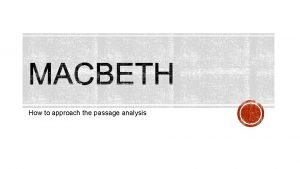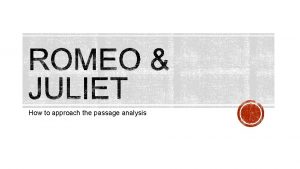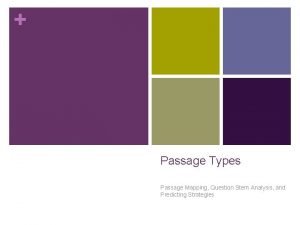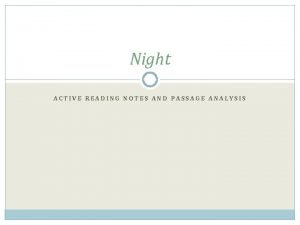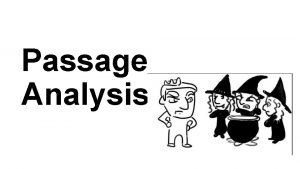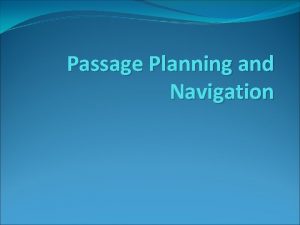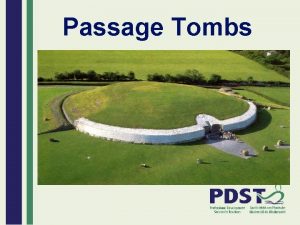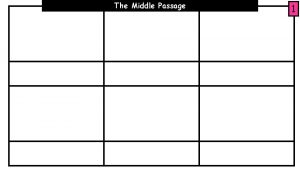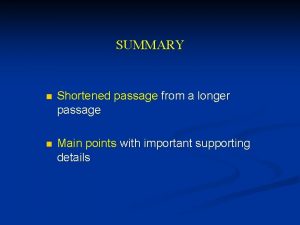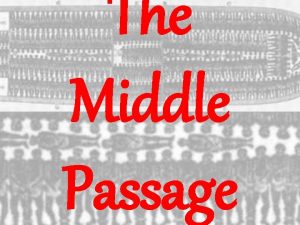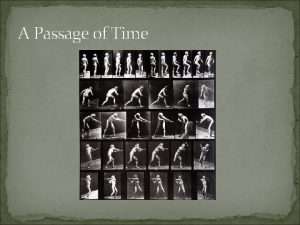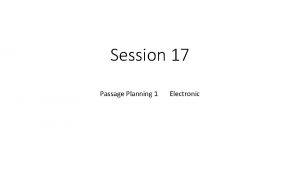How to approach the passage analysis A passage









![§ [“iamb” = unstressed syllable; “penta” = 5; “meter” = rhythmic pattern] § What? § [“iamb” = unstressed syllable; “penta” = 5; “meter” = rhythmic pattern] § What?](https://slidetodoc.com/presentation_image_h/7a493789f47a2c37097834413e3b3dc7/image-10.jpg)








- Slides: 18

How to approach the passage analysis

§A passage analysis is a task that is designed for you to reveal your familiarity of the play’s plot, your in-depth understanding of the characters and their motivations, the key concerns and ideas that are central to the play and the language devices used by Shakespeare to shape meaning and engage the audience.

§ A comprehensive response is one that demonstrates a thorough understanding of context, characters, key concerns and Shakespeare’s use of language. § You cannot do this in a page! Aim to write 3 to 4 detailed, complex paragraphs.

KNOW CONTEXT: Be able to ‘frame’ the passage specifically by act and scene. KNOW CONTENT: What is the passage about? What is happening? What do we learn? KNOW SIGNIFICANCE: Why is the passage significant? What do we learn about the character(s) and their interaction? What do we learn about human nature? How is this message, lesson or understanding delivered?

§ Where does the passage appear in the play (give a context for the passage and a brief statement about its significance) § What happens before or after? Demonstrate your familiarity with the entire play. Give examples from the passage § This could be part your first paragraph

CHARACTERS § What qualities of the characters are shown? What emotions are expressed? § What developments are evident? Are their any obvious changes in a character’s mindset? § Focus on language features that create character/s. Write about the way language informs us of the situation. Give examples from the passage. § This could be part of your first paragraph

§ Introduce this in your first paragraph § Focus on language features that create ideas in the passage. How do these ideas or themes relate to the plot? This is where you return to the main ideas being communicated in the passages and how this is done. § Think about Shakespeare’s intention, ideas, patterns, comments on human behaviour… § Give examples from the passage. § These could be your second/third/fourth paragraphs

§ Now look at the actual words that make up the passage. Turn your focus to the general language features of the passage. § How are the voices presented? What is the rhythm? Think about the punctuation and how it contributes to the rhythm of Shakespeare’s language. § Comment on things such as the vocabulary, the deliberate choice of words, the parts of speech (e. g. adjectives, adverbs, verbs…), repetition, punctuation, tone (include examples from the passage) § Look for: patterns, prose/verse, rhyming verse (rhyming couplets), iambic pentameter, dramatic irony, foreshadowing, alliteration, allusions figurative language- metaphors, similes, personification, symbolism, contrast (opposition of ideas ‘My only love from my only hate…’) etc. § Use your R & J / OMAM glossaries § Give examples from the passage. § This could EITHER be your fourth paragraph OR could be discussed throughout as they link into themes and ideas

§Verse § What? Looks like the verses of a poem § The verse in Romeo and Juliet falls naturally into two parts: (a) blank verse, that is, unrhymed lines in iambic pentameter; (b) rhymed lines in various metres. Associated with upper classes, with high-flown, higher-order ideas. §Prose § What? Looks like an ordinary paragraph § Why? For everyday life and ordinary people/commoners don’t speak in special rhymes, it’s practical and relaxed, used in serious letters, to represent madness (verse would be too orderly or regular). Associated with the low and the vulgar.
![iamb unstressed syllable penta 5 meter rhythmic pattern What § [“iamb” = unstressed syllable; “penta” = 5; “meter” = rhythmic pattern] § What?](https://slidetodoc.com/presentation_image_h/7a493789f47a2c37097834413e3b3dc7/image-10.jpg)
§ [“iamb” = unstressed syllable; “penta” = 5; “meter” = rhythmic pattern] § What? Rhythmic pattern of 5 iambs per line (can be rhyming or unrhyming)

§ What? rhyming couplets (often a, a, b, b, c, c) § Why? For advice, songs, prologues, epilogues, choruses, imaginary plays within plays, supernatural § COUPLETS – a pair of successive lines of verse

§ What? Unrhyming verse (usually iambic pentameter) § Why? Wide range of uses, passionate, refined characters speak in blank verse

§ What? Looks like an ordinary paragraph § Why? For everyday life and ordinary people/commoners don’t speak in special rhymes, it’s practical and relaxed, used in serious letters, to represent madness (verse would be too orderly or regular).

SOLILOQUY Metre/rhythm Poetry/prose Tone Metaphor/simile Imagery/motifs Contrast Dramatic Irony Paradox/oxymoron Sound devices: alliteration, consonance, assonance, onomatopoeia, rhyme

§ What is the context of the passage? (What happens before or after) § Examine the reactions of those characters in the passage § What key concerns of the play are highlighted in this passage? § Comment on Shakespeare’s use of language

§ Act I, Scene IV: Queen Mab Speech § This passage, which is taken from William Shakespeare’s Romeo and Juliet, appears in Act 1 Scene 4. It is important because it conveys to the audience the direct contrast between Mercutio and Romeo’s various approaches to love. Romeo and Mercutio, along with Benvolio, have gathered before the great Capulet feast. All of them are masked and somewhat nervous. However, while Mercutio and Benvolio are excited anticipate the event, Romeo continues to brood over his unrequited love for Rosaline. Mercutio skewers Romeo’s high-flown idealism with a speech about the mythic Queen Mab, which transforms from comedic to dark as the scene progresses.

§ The scene draws a stark contract between Romeo’s melancholy and Mercutio’s playful cynicism. For Romeo, to love is to suffer intensely; he describes his love as a ”heavy burden” that is “too rude, too boist’rous, and it pricks like thorn” (I. IV. 26). Romeo describes love using the language of violence, as to “prick” and draw blood is a violent act. The love between Romeo and Juliet is connected with violence, and Romeo’s words foreshadow Juliet’s fatal self-inflicted dagger wound at the end of the play. For Romeo, love is dangerous and leads to death; he describes himself as being “sore enpierced with his shaft” (I. IV. 19). Mercutio, by contrast, mocks Romeo relentlessly for his idealised view of love, and describes love as silly, pointless and base. Mercutio is positioned as the master truth teller in the play, using comedy and wit to destroy the beliefs and pretensions of those around him. Romeo’s dreams, like Queen Mab, are “the children of an idle brain” (I. IV. 98); in other words, worthless.

§ Mercutio uses the myth of Queen Mab to reveal the debased and degraded nature of love. Mercutio uses puns (playing on words) to demonstrate how apparently ideal love can have an unpleasant and ugly underside. ”Queen Mab”, for instance, is a play on the words “quean” and “mab”, which was Elizabethan slang for prostitution. By making an apparent reference to love, but in fact referring to prostitution, Mercutio reveals a cynical and dark view of love: it is a loveless transaction of buying and selling. At first glance, the figure of Queen Mab is described as the “fairies’ midwife”, riding a fanciful chariot of “empty hazel-nut”, who brings dreams to men as they “life asleep” (I. IV. 54 – 59). This childlike fairy tale, so apparently innocent, swiftly turns dark, as Mab punishes dreams of love: ladies dreaming of kisses are given “blisters plague” as they offend Queen Mab with their bad breath (I. IV. 74 – 75). By the end of the speech, Mab is a “hag” who instructs women how to have sex. By playfully insulting Romeo’s pining over Rosaline, Mercutio reveals his view that love is degrading, low and, ultimately, worth laughing at.
 A switched wan is normally implemented as a
A switched wan is normally implemented as a Cognitive approach vs behavioral approach
Cognitive approach vs behavioral approach Waterfall and shower strategy
Waterfall and shower strategy Avoidance
Avoidance Bandura's reciprocal determinism
Bandura's reciprocal determinism Approach research meaning
Approach research meaning Traditional development approach
Traditional development approach Deep learning approach and surface learning approach
Deep learning approach and surface learning approach Hình ảnh bộ gõ cơ thể búng tay
Hình ảnh bộ gõ cơ thể búng tay Frameset trong html5
Frameset trong html5 Bổ thể
Bổ thể Tỉ lệ cơ thể trẻ em
Tỉ lệ cơ thể trẻ em Voi kéo gỗ như thế nào
Voi kéo gỗ như thế nào Tư thế worm breton là gì
Tư thế worm breton là gì Hát lên người ơi
Hát lên người ơi Các môn thể thao bắt đầu bằng tiếng đua
Các môn thể thao bắt đầu bằng tiếng đua Thế nào là hệ số cao nhất
Thế nào là hệ số cao nhất Các châu lục và đại dương trên thế giới
Các châu lục và đại dương trên thế giới Công thức tính độ biến thiên đông lượng
Công thức tính độ biến thiên đông lượng




















